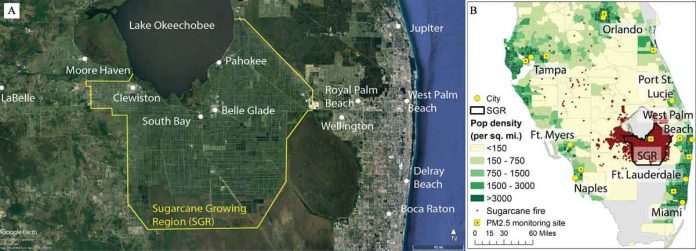According to a new study from Florida State University, sugarcane fires in South Florida emit harmful particulate matter in quantities comparable to motor vehicles, and are a factor in regional mortality rates.
Their findings have been published in Environmental Health Perspectives.
“Over the years, there have been numerous complaints from citizens who live within or near these fields about frequent ashfall, poor air quality, and negative health consequences from the smoke,” said Holly Nowell, the study’s lead author and an FSU postdoctoral researcher in the Department of Earth, Ocean, and Atmospheric Science. “While previous research has shown that fires have a negative impact on air quality, no previous research has quantified the mortality impacts.”
According to Nowell and her colleagues, exposure to fine particles in sugarcane smoke causes one to six deaths per year in South Florida.
Prescribed burns affect more than 2 million acres in Florida each year. The majority of that is to reduce wildfire risk and preserve habitat for certain species. However, approximately 400,000 acres of sugarcane fields are burned prior to harvest in order to remove non-sugar vegetation on the sugarcane stalk.
The majority of Florida’s sugarcane burning occurs along the south shore of Lake Okeechobee in the cities of Belle Glade, Clewiston, and Pahokee. Sugar farming is a major economic driver in the region, employing over 14,000 people and generating approximately $800 million in revenue per year.
When this vegetation is burned, it produces smoke with unhealthful particles less than 2.5 microns in diameter that can be inhaled deep into the lungs. Previous research has linked these particles to health issues such as asthma, lung cancer, and cardiovascular disease.
The team discovered that mortality rates from this exposure were nearly ten times higher for residents living next to the fields than for those living outside of the immediate area.
To estimate burning-related exposures, the researchers used measurements from a variety of sources, including satellite sensors, ground-based monitoring, and a 3D computer model of smoke dispersion.They also estimated daily sugarcane fire emissions based on Florida burn permits and examined demographic and health impact data to look at causes of mortality.
They discovered that sugarcane fires produced 5,100 metric tonnes of these small 2.5-micron particles each year. In comparison, on-road motor vehicles in Florida emit approximately 6,100 metric tonnes of these particles.
Researchers pointed out that, while these figures are concerning, the region’s air quality and particle pollution levels meet current US air quality standards.
“We started this work because we wanted to better understand the public issues and controversy surrounding sugarcane fires and smoke in Florida,” said Christopher Holmes, Associate Professor of Earth, Ocean, and Atmospheric Science. “
On the one hand, some residents in the sugarcane region around Lake Okeechobee are concerned about the sugarcane smoke’s impact on asthma and respiratory health. The sugarcane industry and its supporters, on the other hand, have pointed to measurements indicating that average air particle pollution is within federal guidelines.”
According to Holmes and Nowell, this study is just the beginning of a larger conversation about the health and air quality impacts of sugarcane burning, and they hope that their work will simply be used as environmental agencies and lawmakers continue to investigate the practice and develop guidelines for burning.
“Whether or not sugarcane burning should continue is a hotly debated topic on both sides,” Nowell said. “We want growers, the public, and the government to make informed decisions about the effects of burning.”

